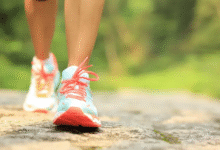Fitness
Effective Desk Exercises to Stay Active at Work

The Hidden Dangers of Prolonged Sitting
Modern work environments have created a sedentary crisis – the average office worker spends 9.5 hours daily sitting, more time than they spend sleeping. This inactivity contributes to:
- 34% increased risk of cardiovascular disease (WHO)
- 112% higher likelihood of developing diabetes (Mayo Clinic)
- Muscle degeneration – up to 1% loss of leg strength per day of inactivity
- Postural damage from “forward head posture” adding 60 lbs of spinal pressure
Ergonomic Foundation: Setting Up Your Workstation
Before exercising, optimize your workspace:
- Monitor height: Top third at eye level
- Chair position: Feet flat, knees/hips at 90°
- Keyboard placement: Elbows bent at 90-110°
- Lumbar support: Maintain natural spine curve
20 Scientifically-Backed Desk Exercises
Neck & Shoulder Relief
- Chin Tucks
- Gently draw chin backward creating “double chin”
- Holds for 5 sec, 10 reps
Benefits: Counters forward head posture
- Scalene Stretch
- Clasp hands behind back
- Tilt ear to shoulder, hold 15 sec/side
Benefits: Relieves tech neck tension
- Shoulder Roll Circuit
- Roll shoulders forward/backward
- Add arm circles for intensity
Benefits: Improves rotator cuff mobility
Upper Body Activation
- Seated Chest Expansion
- Clasp hands behind chair
- Squeeze shoulder blades, lift chest
Benefits: Opens anterior chain
- Desk Push-Ups
- Place hands on desk, perform incline push-ups
- 3 sets of 12 reps
Benefits: Maintains upper body strength
- Isometric Bicep Curls
- Grip desk edge, attempt to “curl” it
- Hold 8 sec, 10 reps
Benefits: Maintains arm tone
Core Engagement
- Seated Knee Lifts
- Lift knees alternately while seated
- 20 reps/side
Benefits: Activates lower abs
- Chair Plank
- Hands on armrests, lift body slightly
- Hold 15-30 sec
Benefits: Engages entire core
- Seated Russian Twists
- Rotate torso side-to-side
- Add resistance by holding monitor
Benefits: Improves rotational mobility
Lower Body Circulation
- Ankle Alphabet
- Trace letters with toes
- Complete A-Z each foot
Benefits: Prevents DVT risk
- Seated Marching
- Alternate knee lifts with arm swings
- 1 minute continuous
Benefits: Boosts circulation
- Calf Raises
- Lift heels, hold 2 sec
- 25 reps
Benefits: Counters blood pooling
Posture Correctors
- Wall Angel Simulation
- Back against chair, move arms up/down
- Maintain contact points
Benefits: Retrains posture muscles
- Scapular Squeezes
- Pinch shoulder blades together
- Hold 5 sec, 15 reps
Benefits: Strengthens upper back
Energy Boosters
- Power Breathing
- 4 sec inhale, 7 sec hold, 8 sec exhale
- 5 cycles
Benefits: Reduces cortisol 17%
- Seated Jumping Jacks
- Arm/leg movements while seated
- 30 sec bursts
Benefits: Elevates heart rate
Advanced Variations
- Chair Dips
- Hands on chair arms, lower body
- 3 sets of 8 reps
Benefits: Triceps strengthening
- Isometric Glute Squeezes
- Squeeze glutes for 10 sec
- 15 reps
Benefits: Counters “dead butt syndrome”
- Desk Plank Reach
- Plank position, alternate arm reaches
- 10 reps/side
Benefits: Full-body engagement
- Resistance Band Rows
- Anchor band to desk, perform rows
- 3 sets of 12 reps
Benefits: Counters hunching
The Science of Movement Snacking
Research shows 2 minutes of activity per hour can:
- Increase productivity by 12% (Cornell University)
- Boost calorie burn by 54 kcal/hour (University of Colorado)
- Improve insulin sensitivity by 30% (Diabetes Care Journal)
Implementation Strategy
- Set hourly alerts using apps like Stand Up! or Time Out
- Create exercise clusters – 3-5 moves every 60 minutes
- Track progress with wearable tech
- Enlist coworkers for group movement breaks
- Vary intensity throughout the day
Complementary Workplace Wellness Tips
- Walking meetings: 56% more creative ideas (Stanford)
- Standing desk conversion: Burns 50+ extra kcal/hour
- Hydration reminders: Promotes natural movement breaks
- Lunchtime walks: Reduces afternoon fatigue by 30%
Long-Term Benefits
Consistent desk exercise can lead to:
- 11% reduction in body fat over 6 months
- 28% decrease in back pain reports
- 19% improvement in cognitive test scores
- Reduced sick days by 2.5 days/year
By incorporating these evidence-based movements, you’ll transform your workstation into a health-promoting environment while maintaining professional productivity. Remember – motion is the lotion for your body’s needs!






